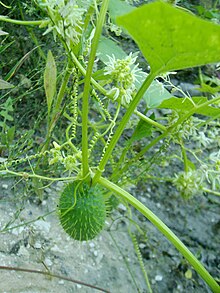Echinocystis
| Echinocystis lobata | |
|---|---|
 |
|
| Scientific classification | |
| Kingdom: | Plantae |
| (unranked): | Angiosperms |
| (unranked): | Eudicots |
| (unranked): | Rosids |
| Order: | Cucurbitales |
| Family: | Cucurbitaceae |
| Subfamily: | Cucurbitoideae |
| Tribe: | Sicyeae |
| Subtribe: | Cyclantherinae |
| Genus: |
Echinocystis Torr. & A.Gray |
| Species: | E. lobata |
| Binomial name | |
|
Echinocystis lobata (Michx.) Torr. & A. Gray |
|
| Synonyms | |
Echinocystis is a monotypic genus in the gourd family, Cucurbitaceae. The sole species is E. lobata, commonly called wild cucumber, prickly cucumber, or balsam apple. It is an annual, sprawling plant that is native to North America.
Echinocystis lobata is an annual vine that produces stems that can be as long as 8 m (26 ft) and which climb, with the help of coiling, branched tendrils, over shrubs and fences or trail across the ground. The stems are angular and furrowed. The leaves are alternate with long petioles, five palmate lobes and no stipules. The flowers are monoecious, with separate male and female blooms on the same plant. The male flowers are in long-stemmed, upright panicles. Each flower has a white, or greenish-yellow, corolla with six slender lobes. The male flower has a single central stamen with a yellow anther. The female flower has a single stigma and is borne on a short stalk at the base of the flower panicle, with the spiky globular inferior ovary being immediately beneath. The fruit is a prickly, inflated capsule up to 5 cm (2 in) long with two pores and four seeds. It resembles a tiny spiny water melon, persists all winter and then opens at the bottom, liberating the seeds. This species can be distinguished from the oneseed bur cucumber (Sicyos angulatus) by the six-lobed corolla and the lack of the clustered fruits that that plant bears.
The native range across North America includes forty U.S. states (excluding Nevada, Hawaii, and Alaska; and most of the far Southeastern states); and nine Canadian provinces. It has also been reported as an uncommon invasive species in the Örség Landscape Protection Area of Hungary near the Austrian-Slovenian border. Similarly it is reported as an adventive alien species that grew in wetland, grassland and human effected areas of the Carei Plain natural protected area, western Romania.
...
Wikipedia
